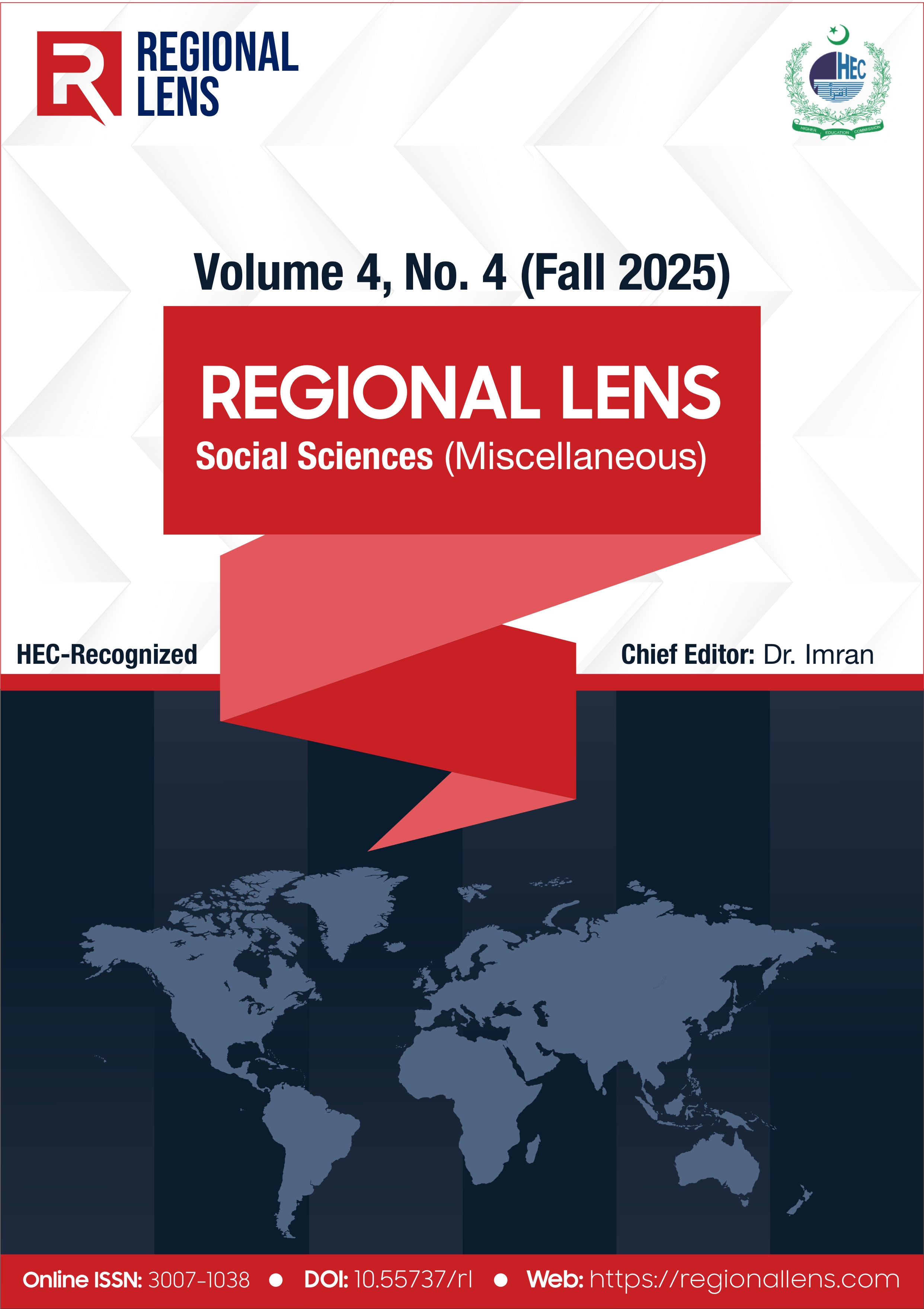Self-esteem and Aggression in University Students: Investigating the Mediating Role of Social Comparison
DOI:
https://doi.org/10.55737/rl.2025.44120Keywords:
Self-esteem, Social Comparison, Aggression, Mediation, University StudentsAbstract
Purpose of the present study was to explore indirect relationship between self-esteem and aggression through social comparison among university students. The sample comprised of 305 male and female students from three different universities in Quetta city. Rosenberg Self Esteem Scale (1965) was used for measuring self-esteem, and Buss-Perry Aggression Questionnaire (Buss & Perry, 1992) was used for measuring Aggression and Social Comparison Scale by Allan and Gilbert (1995) was used to measure students` tendency to evaluate themselves relative to others. Pearson Correlation results showed non-significant relationship of self-esteem with aggression. Link between self-esteem and social comparison was significant and negative. Significant positive association was observed between social comparison and aggression. Regression analysis endorsed both self-esteem and social comparison as significant predictors of aggression as outcome variable. Mediation analysis revealed that social comparison completely mediated the relationship of self-esteem with aggression. No significant differences were observed on self-esteem, aggression and social comparison between male and female students. It is concluded based on the findings of the present study that youth with low self-esteem involve in more social comparison and that more social comparison result in more aggression in such individuals. The findings of the present study are discussed in the context of the past research and suggestions for the future research are also included.
References
Allan, S., & Gilbert, P. (1995). A social comparison scale: Psychometric properties and relationship to psychopathology. Personality and Individual Differences, 19(3), 293–299. https://doi.org/10.1016/0191-8869(95)00086-L
Alodia, A., & Suryadi, D. (2021). The relationship between social comparison and self-esteem among late adolescent Instagram users. Advances in Social Science, Education and Humanities Research. https://doi.org/10.2991/assehr.k.210805.083
Anderson, C. A., & Bushman, B. J. (2002). Human aggression. Annual Review of Psychology, 53, 27–51. https://doi.org/10.1146/annurev.psych.53.100901.135231
Archer, J. (2006). Testosterone and human aggression: An evaluation of the challenge hypothesis. Neuroscience & Biobehavioral Reviews, 30(3), 319–345. https://doi.org/10.1016/j.neubiorev.2004.12.007
Bandura, A. (1973). Aggression: A social learning analysis. Prentice-Hall.
Baumeister, R. F., Smart, L., & Boden, J. M. (1996). Relation of threatened egotism to violence and aggression: The dark side of high self-esteem. Psychological Review, 103(1), 5–33. https://doi.org/10.1037/0033-295X.103.1.5
Bushman, B. J., & Baumeister, R. F. (1998). Threatened egotism, narcissism, self-esteem, and direct and displaced aggression: Does self-love or self-hate lead to violence? Journal of Personality and Social Psychology, 75(1), 219–229. https://doi.org/10.1037/0022-3514.75.1.219
Bushman, B. J., Baumeister, R. F., & Phillips, C. M. (2000). Do people aggress to improve their mood? Catharsis beliefs, affect regulation opportunity, and aggressive responding. Journal of Personality and Social Psychology, 81(1), 17–32. https://doi.org/10.1037/0022-3514.81.1.17
Buss, A. H., & Perry, M. (1992). The aggression questionnaire. Journal of Personality and Social Psychology, 63(3), 452–459. https://doi.org/10.1037/0022-3514.63.3.452
Bynner, J. M., O'Malley, P. M., & Bachman, J. G. (1981). Self-esteem and delinquency revisited. Journal of Youth and Adolescence, 10(6), 515–523. https://doi.org/10.1007/BF02087937
Chou, H. T. G., & Edge, N. (2012). "They are happier and having better lives than I am": The impact of using Facebook on perceptions of others' lives. Cyberpsychology, Behavior, and Social Networking, 15(2), 117–121. https://doi.org/10.1089/cyber.2011.0324
Compassionate Mind Foundation. (n.d.). Social Comparison Scale. https://www.compassionatemind.co.uk/resource/scales
Coopersmith, S. (1981). The antecedents of self-esteem. W. H. Freeman
Crocker, J., & Wolfe, C. T. (2001). Contingencies of self-worth. Psychological Review, 108(3), 593–623. https://doi.org/10.1037/0033-295X.108.3.593
DeWall, C. N., Anderson, C. A., & Bushman, B. J. (2015). The general aggression model: Theoretical extensions to violence. Psychology of Violence, 5(3), 245–258. https://doi.org/10.1037/a0023842
Dijkstra, P., Kuyper, H., van der Werf, M. P. C., Buunk, A. P., & van der Zee, Y. G. (2008). Social comparison in the classroom: A review. Review of Educational Research, 78(4), 828–879. https://doi.org/10.3102/0034654308321210
Dollard, J., Doob, L. W., Miller, N. E., Mowrer, O. H., & Sears, R. R. (1939). Frustration and aggression. Yale University Press.
Donnellan, M. B., Trzesniewski, K. H., Robins, R. W., Moffitt, T. E., & Caspi, A. (2005). Low self-esteem is related to aggression, antisocial behavior, and delinquency. Psychological Science, 16(4), 328–335. https://doi.org/10.1111/j.0956-7976.2005.01535.x
Festinger, L. (1954). A theory of social comparison processes. Human Relations, 7(2), 117–140. https://doi.org/10.1177/001872675400700202
Gibbons, F. X., & Buunk, B. P. (1999). Individual differences in social comparison: Development of a scale of social comparison orientation. Journal of Personality and Social Psychology, 76(1), 129–142. https://doi.org/10.1037/0022-3514.76.1.129
Hamilton, L. M. (2019). The relationship between self-esteem and aggression in undergraduate students [Unpublished master's thesis]. University of California.
Han, L., Li, W., Wang, X., Xu, Y., & Zhao, J. (2024). Social comparison and aggression: The mediating role of relative deprivation and moderating role of covert narcissism. International Journal of Psychology, 59(5), 646-656. https://doi.org/10.1002/ijop.13129
Hu, C., Cai, Y., Wang, R., Gan, Y., & He, N. (2023). The relationship between self esteem and aggressive behavior among Chinese adolescents: A moderated chain mediation model. Psychology, 14, Article 1191134. https://doi.org/10.3389/fpsyg.2023.1191134
Hyde, J. S. (2005). The gender similarities hypothesis. American Psychologist, 60(6), 581–592. https://doi.org/10.1037/0003-066X.60.6.581
Leary, M. R., & Baumeister, R. F. (2000). The nature and function of self-esteem: Sociometer theory. In M. P. Zanna (Ed.), Advances in experimental social psychology (Vol. 32, pp. 1–62). Academic Press. https://doi.org/10.1016/S0065-2601(00)80003-9
Leary, M. R., Tambor, E. S., Terdal, S. K., & Downs, D. L. (1995). Self-esteem as an interpersonal monitor: The sociometer hypothesis. Journal of Personality and Social Psychology, 68(3), 518–530. https://doi.org/10.1037/0022-3514.68.3.518
Miles, D. R., & Carey, G. (1997). Genetic and environmental architecture of human aggression. Journal of Personality and Social Psychology, 72(1), 207–217. https://doi.org/10.1037/0022-3514.72.1.207
Myburgh, C., Poggenpoel, M., & Fourie, C. M. (2020). Predictors of aggression of university students. Health SA Gesondheid, 25. https://doi.org/10.4102/hsag.v25i0.1096
Nesi, J., & Prinstein, M. J. (2015). Using social media for social comparison and feedback-seeking: Gender and popularity moderate associations with depressive symptoms. Journal of Abnormal Child Psychology, 43(8), 1427–1438. https://doi.org/10.1007/s10802-015-0020-0
Noon, E. J. (2020). Compare and despair or compare and explore? Instagram social comparisons of ability and opinion predict adolescent identity development. Cyberpsychology, 14(2). https://doi.org/10.5817/CP2020-2-1
Orth, U., & Robins, R. W. (2014). The development of self-esteem. Current Directions in Psychological Science, 23(5), 381–387. https://doi.org/10.1177/0963721414547414
Park‐Higgerson, H. K., Perumean‐Chaney, S. E., Bartolucci, A. A., Grimley, D. M., & Singh, K. P. (2008). The evaluation of school‐based violence prevention programs: A meta‐analysis. Journal of School Health, 78(9), 465-479. https://doi.org/10.1111/j.1746-1561.2008.00332.x
Podsakoff, P. M., MacKenzie, S. B., Lee, J. Y., & Podsakoff, N. P. (2003). Common method biases in behavioral research: A critical review of the literature and recommended remedies. Journal of Applied Psychology, 88(5), 879–903. https://doi.org/10.1037/0021-9010.88.5.879
Rosenberg, M. (1965). Society and the adolescent self-image. Princeton University Press.
Shindler, J. (2009). Transformative classroom management: Positive strategies to engage all students and promote a psychology of success. Jossey-Bass.
Silverberg, A. (2010). The Relationship between Self-Esteem and Aggression. Undergraduate Psychology Research Methods Journal, 1(12), 6. https://digitalcommons.lindenwood.edu/psych_journals/vol1/iss12/6
Tesser, A. (1988). Toward a self-evaluation maintenance model of social behavior. In L. Berkowitz (Ed.), Advances in experimental social psychology (Vol. 21, pp. 181–227). Academic Press. https://doi.org/10.1016/S0065-2601(08)60227-0
Toch, H. (1992). Violent men: An inquiry into the psychology of violence (Rev. ed.). American Psychological Association.
Vogel, E. A., Rose, J. P., Roberts, L. R., & Eckles, K. (2014). Social comparison, social media, and self-esteem. Psychology of Popular Media Culture, 3(4), 206–222. https://doi.org/10.1037/ppm0000047
Ziqiang, L., Zhen, W., & Peixin, L. (2007). The relationship of adolescent’s self esteem and aggression: The role of mediator and moderator. Acta Psychologica Sinica, 39(5), 845–851.




